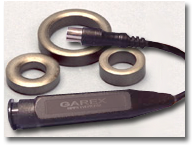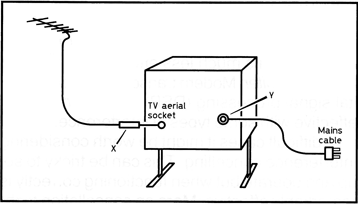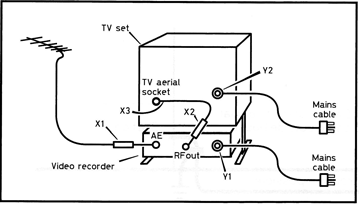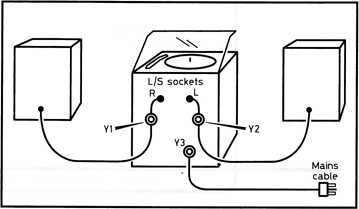Using EMC filters and ferrites
 This page offers more detailed instructions on the use of filters and ferrite rings to solve frequently encountered breakthrough problems.
This page offers more detailed instructions on the use of filters and ferrite rings to solve frequently encountered breakthrough problems.
The RSGB Shop is a source for some EMC filters and advice, although we cannot cater for all circumstances.
TV and video
With a TV set alone, a suitable filter in the coaxial aerial cable at ‘X’ in Fig 1 may be all that is required to cure breakthrough. If this does not cure the problem, then a ferrite ring (see below) may also be required on the mains cable at ‘Y’.

Fig. 1: Fitting filters to TV set alone
Fig. 2 shows a video recorder with its RF output connected to the aerial socket of a TV. A filter and/ or “braid-breaker” (see below) should be fitted in the coaxial cable at ‘X1’ but if this is not sufficient, another should be fitted at either ‘X2’ or at ‘X3’. In some cases, ferrite rings are required on the mains cables at ‘Y1’ and/or at ‘Y2’. The use of good quality SCART or HDMI cables instead of RF links can offer improved immunity.

Fig. 2: Fitting filters to a TV set with a video recorder
Audio systems
RF breakthrough in an audio system can often be cured by fitting ferrite rings to the loudspeaker cables as shown by ‘Y1’ and ‘Y2’ in Fig 3. In some cases, additional ferrite rings may be required such as at ‘Y3’ on the mains cable. Rings may also be required on audio cables or mains cables of other units such as a cassette deck or CD player.

Fig. 3: Fitting common mode chokes to an audio system
Filter types and characteristics
All the filters listed below allow UHF TV signals to pass through but as with any filter, there is a small loss in the pass band. The HPF2 allows both VHF/ FM broadcast radio (Band 2, 88-108MHz) and UHF TV to pass through.
In many cases, particularly on the HF bands, amateur signals are picked up by the TV aerial downlead rather than by the TV aerial itself. If this causes breakthrough, a so-called “braid-breaker” is required. This could be part of a filter or could be a separate unit. There are several types of “braid-breaker” although some of these do not actually break the braid at DC:
- A ferrite ring choke. Winding a length of coaxial cable onto one or more ferrite rings has the advantage that it introduces very little loss or impedance mismatch for the wanted UHF signal and also maintains the integrity of the coaxial cable screening
- A 1:1 transformer braid-breaker. This is included in the BB1 and HPFS filters. It gives excellent rejection of common mode signals on the HF and lower VHF bands and can be more effective than ferrite rings on the HF bands below 10MHz. Nevertheless, it introduces a significant loss of the wanted UHF TV signal (up to about 4dB).
- A capacitive braid-breaker. This type, which is easy to construct [2], has 4.7pF capacitors in series with both the inner and the braid. Although this filter has a low pass-band loss, the use of another type of braid-breaker is generally preferable.
- A resonant braid-breaker. The TNF2 range include a parallel resonant circuit in series with both the inner and the braid. This is only effective on one particular amateur band and in some cases, its use can increase breakthrough of other frequencies.
Use of ferrite chokes
RF breakthrough into electronic equipment can be caused by signals being picked up on external cables such as loudspeaker cables, mains cables, etc. This effect can often be reduced or eliminated by winding the affected cable onto a suitable ferrite core which presents a high impedance to unwanted RF signals without affecting the wanted signals. For the best chance of success, it is important to use a suitable grade of ferrite with enough turns in order to obtain the highest possible impedance at the frequencies of interest (3-5 Kohms or more is possible).
Winding a choke
Above about 10MHz, it becomes increasingly important to minimise the stray capacitance between the ends of the winding. This stray capacitance can be reduced by using the winding method shown in Fig 4. It is vital that the end of the cable is always threaded through the core in the same direction as shown by the arrows. Finally, the ends should be secured with self-locking cable ties as shown. If the cable is very thick, if it has connectors which cannot easily be removed or if it is not long enough, the best solution is usually to make up a short plug-in extension lead using the thinnest suitable cable. This is wound through a ferrite core and then fitted with suitable connectors. Normal TV coaxial cable should not be wound tightly through a ferrite ring or onto a ferrite rod otherwise it may collapse internally and short-circuit. Instead, a one metre length of miniature 75 ohm coaxial cable should be used and fitted with coaxial connectors.
Ferrite ring core characteristics
There is no single grade of ferrite which is ideal for EMC use on all HF and VHF amateur bands. The Fair-Rite type 43 material gives good results from 7MHz upwards but for the 1.8MHz and 3.5MHz bands, better results are obtained with a higher permeability ferrite such as Fair-Rite type 73 material or a pair of Neosid 28-041-28 type rings, if available.
At VHF, minimising stray capacitance becomes particularly important so for 144MHz, the recommended number of turns should be halved to 6 or 7 on a ring core or 3 for a clip-on core.

Fig. 4: Recommended winding method for ring cores
Please note: These pages are intended for members of the Radio Society of Great Britain, but are available to non-members on the understanding that any information is given in good faith and the society cannot be responsible for any misuse or misunderstanding.










